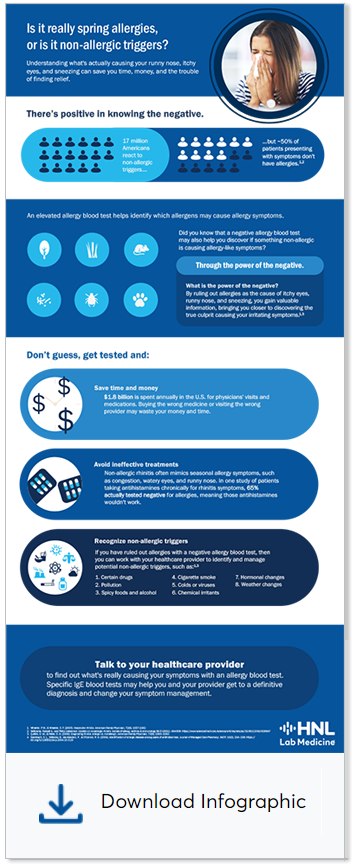Is it Allergies or Something Else?
Spring allergies can be extremely uncomfortable for you and your family, but what if those seasonal allergy symptoms are actually non-allergic rhinitis? Don’t guess, get tested! You can
Save time and money
 Healthcare can be expensive. $1.8 billion is spent annually in the U.S. for physicians’ visits and medications¹. Buying the wrong medicine or visiting the wrong provider can waste your money and time.
Healthcare can be expensive. $1.8 billion is spent annually in the U.S. for physicians’ visits and medications¹. Buying the wrong medicine or visiting the wrong provider can waste your money and time.
Don’t undergo ineffective, costly, or inappropriate treatment. Simply getting tested can avoid the hassle of time-consuming visits and expensive medications.
Avoid ineffective treatments
Non-allergic rhinitis often mimics seasonal allergy symptoms, such as congestion, watery eyes, and runny nose¹. If you are frustrated and confused because your over-the-counter medications aren't relieving symptoms, diagnostic testing might be a good solution.one study of patients taking antihistamines chronically for rhinitis symptoms, 65% actually tested negative for allergies, meaning those antihistamines wouldn't work².
A diagnostic blood test can help inform your medical treatment- whether results indicate allergic sensitizations (positive) or not (negative).
 Recognize non-allergic triggers
Recognize non-allergic triggers
A positive test can identify allergic rhinitis, but there’s no specific test to diagnose non-allergic rhinitis¹. It’s diagnosed through exclusion. If you’ve ruled out allergies with a negative allergy blood test, then you can work with your healthcare provider to identify and manage potential non-allergic triggers. Some non-allergic triggers include certain drugs, spicy foods and alcohol, hormonal changes, viruses and bacteria, cigarette smoke, weather changes, pollution, and chemical irritants¹,³.
A specific blood test, along with your medical history and medical evaluation, can help provide clarification on whether your symptoms are allergic or non-allergic rhinitis. Visit your healthcare provider today to get started on the path to a symptom-free spring!

REFERENCES
¹Wheeler, P.W., & Wheeler, S. F. (2005). Vasomotor rhinitis. American Family Physician, 72(6), 1057-1062.
²Szeinbach, S. L., Williams, B., Muntendam, P., & O'Connor, R. D. (2004). Identification of allergic disease among users of antihistamines. Journal of Managed Care Pharmacy: JMCP, 10(3), 234–238. https://doi.org/10.18553/jmcp.2004.10.3.234
³Quillen, D. M., & Feller, D. B. (2006). Diagnosing rhinitis: allergic vs. nonallergic. American Family Physician, 73(9), 1583–1590.